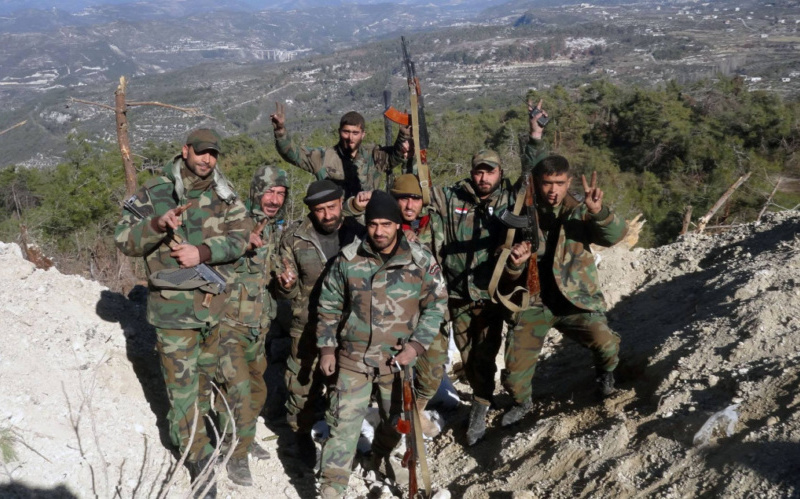Assad regime fighters near Kabani in Latakia Province in northwest Syria
The Assad regime carried out a chlorine attack in northwest Syria in May, according to analysts and the US Government.
The Health Directorate for Idlib Province, under assault by a Russia-regime offensive, said on May 19 that four fighters from the Islamist bloc Hay’at Tahrir al-Sham were admitted for treatment of “toxic injuries as a result of their exposure to toxic gases”. The symptoms — including respiratory problems, vomiting, and burning in the throat — pointed to chlorine poisoning.
The incident occurred during a Russia-regime assault on a key position in neighboring northeast Latakia Province, the hilltop town of Kabani. Since the launch of the offensive in late April, the offensive has repeatedly failed to capture the position.
The claim circulated on social media at the time, but failed to gain traction. While the Assad regime has used sarin nerve agent or chlorine on scores of occasions since 2012 — with 33 of the attacks confirmed by the UN — there had been no documented attack since its assault on Douma near Damascus in April 2018, killing 43 civilians. Because HTS includes the faction Jabhat al-Nusra, formerly linked to Al Qa’eda, and has been accused of abuses in Idlib, its fighters as victims was treated with scepticism by many observers.
But White Helmets civil defense collected biological evidence of blood, saliva, and urine, took cloth samples, and recorded testimony of the victims and physicians who confirmed the diagnosis of cholorine poisoning with a “pungent chlorine smell”. A test on samples indicated methane and chlorine residue.
Photographs pointed to a munition used by the regime in both conventional and chemical attacks.
Soon after, images of the munition remnants and victims began circulating among diplomats and experts. I pasted three such photos below, showing an improvised munition with a 107mm rocket motor. The angle of the photos did not allow for geolocation (beyond soil matching). /9 pic.twitter.com/DfoyjKiKPs
— Tobias Schneider (@tobiaschneider) September 26, 2019
The Global Public Policy Institute, which published a detailed report in February on the Assad regime’s chemical attacks, assessed the evidence and concluded that chlorine was used.
US: “Assad Regime Used Chlorine on 19 May”
There was still little attention to the incident until Wednesday, when US Secretary of State Mike Pompeo said American agencies have “concluded that the Assad regime used chlorine as a chemical weapon on 19 May”.
But speaking on the sidelines of the UN General Assembly, Pompeo distanced the Trump Administration from any response beyond rhetoric.
In April 2017, the US fired missiles on the regime’s Shayrat airbase, from which a warplane carried out the sarin attack a week earlier on Khan Sheikhoun in Idlib Province, killing about 90 people and wounding hundreds. In April 2018, responding to the Douma chlorine attack, the US, Britain, and France struck three complexes connected to the regime’s chemical weapons program.
In a confused sentence — given that chlorine was used in Douma — Pompeo said, “This [the Latakia attack] is different in some sense because it was chlorine…but know that President Trump has been pretty vigorous in protecting the world from the use of chemical weapons.”
The Secretary of State’s assertion of measures beyond words was limited to the note that the Administration has imposed sanctions on two Russian entities for providing fuel to the Assad regime.
The five-month Russia-regime offensive has taken part of the last major opposition area in Syria, including almost all of northern Hama Province and part of southern Idlib.
Attacks on civilian areas have killed more than 1,000 people, wounded thousands, and displaced more than 400,000 of about 3 million people — 20% of Syria’s remaining population — in greater Idlib.

